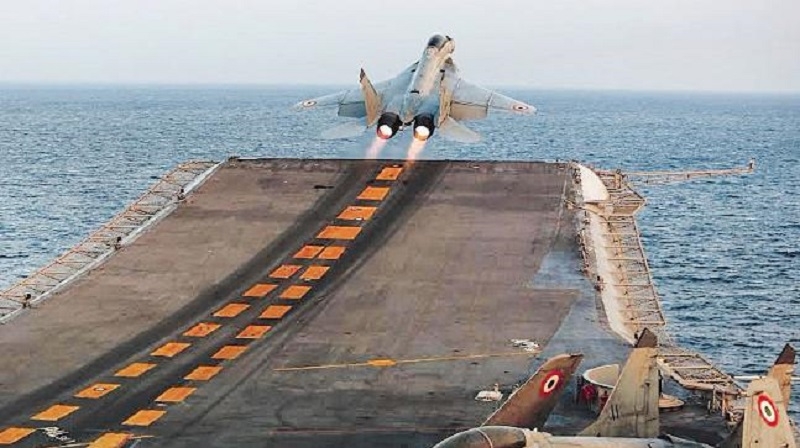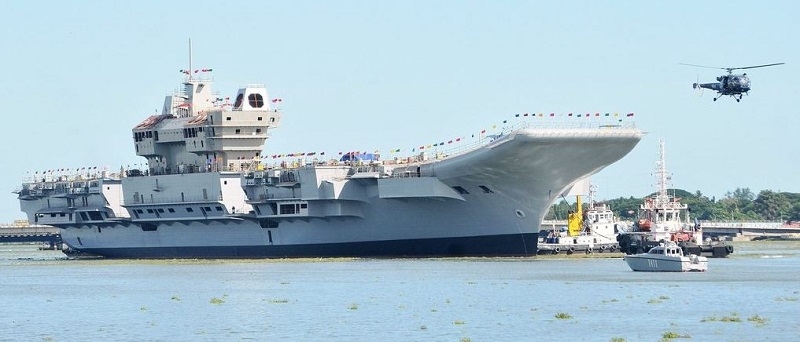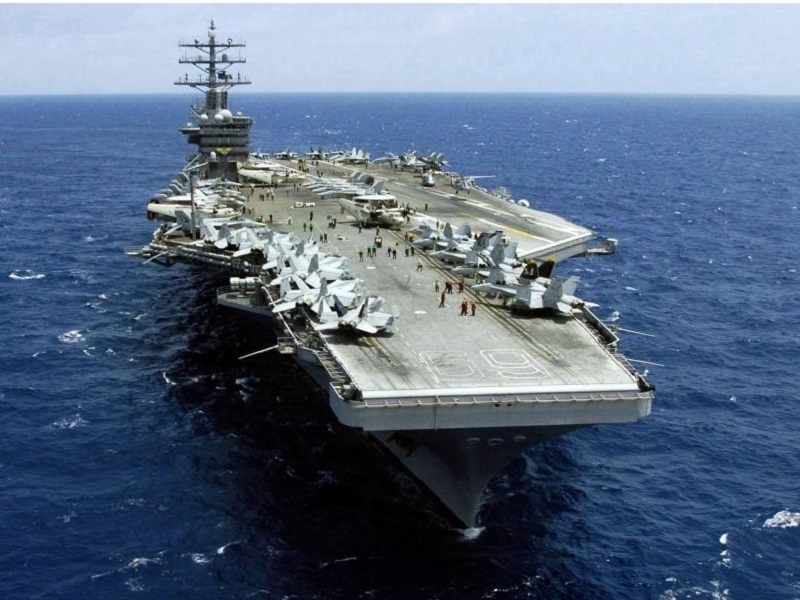Can Aircraft Carriers effectively dominate Indian Ocean Region against adversaries?

Infrequently, there is informed public debate on the efficacy of aircraft carriers to effectively exercise sea control and domination of Indian Ocean Region (IOR) known as India’s maritime domain or area of influence or backyard.
In particular to deter and counter potential Chinese intentions in the IOR - geopolitical theory euphemistically termed as the String of Pearls - which refers to the network of Chinese military and commercial facilities and relationships along its sea lines of communication, which extend from the Chinese mainland to Port Sudan in the Horn of Africa.
The Malacca Straights - the choke point for oil trade - runs between Indonesia, Malaysia and Singapore – shortest sea route between African and Persian Gulf Suppliers and Asian Markets. About 80-90 percent of the crude oil imported by China, Japan and South Korea is shipped through the Strait of Malacca and then the South China Sea.
In the face of such geo-strategic scenario and current and futuristic threat perceptions, the strategic opportunity available for exploiting the immense geo strategic significance of the Indian Southern Peninsula, as a “Dagger”, jetting into the IOR and the “Andaman and Nicobar Islands (ANI)” acting as a shield and located atop the Malacca Straights and its far reaching significance is rarely debated and highlighted.
What are the implications/advantages accruing out of India’s geo strategic location? Even a layman would highlight that the main land mass and the ANI territories enables India to project capability to dominate the IOR region and its main shipping lanes and deter misadventures by adversaries. Add to it, the need to factor rapidly changing nature and character of naval combat and its fallout.
Stating the obvious, the roles of the Navies world over include: power projection; sea control and sea denial; anti-piracy; and other lesser roles. And, the means available to carry out the roles include: submarines, aircraft carriers, destroyers, frigates, corvettes, missile boats, land based anti-ship missiles, surveillance aircraft, minesweepers, landing ships and others of various types.
Most important, India today has a wide range of combat systems developed and produced. For example, the Brahmos Missiles - a medium-range ramjet supersonic cruise missile- that can be launched from submarine, ships, aircraft, or land. It is the world's fastest anti-ship supersonic sea skimming cruise missile in operation in the world. Its unit cost is US$2.75 million with range of 500 km to be upgraded to 600 km (air launched missile with 400 Km) with accuracy of 1 m circular error probability. The land and ship launched versions are already in service, with the air and submarine-launched versions currently in the testing phase. A hypersonic version of the missile, Brahmos-II, is also presently under development with a speed of Mach 7-8 to boost aerial fast strike capability to be ready for testing by 2020.
Furthermore, the DRDO that has also developed and produced a wide range of missiles to include: Akash surface-to-air missile; Prithvi – 1, II and II surface to surface ballistic missile; Dhanush - ship-launched surface-to-surface ballistic missile; K Missile family – 1, 4, and 5 submarine launched ballistic missile; Shaurya - surface-to-surface hypersonic tactical missile; Nirbhay: long-range subsonic cruise missile.
In sum, with the technology breakthroughs indigenously delivered and available in all mediums – surface to ship, ship to ship, submarines to ship and air to ship – surely there are various strategic alternative strategic options available to deter adversaries in the IOR region.
A viable credible mix of land to ship based missiles and fighter aircraft supported by air refuelling facility, air and sea-launched supersonic cruise missiles, and very quiet ballistic missile nuclear attack submarines, destroyers/frigates/missile boats with ship-to-ship missiles can thwart any enemy naval forces to pose major challenges both in the EEZ and also on the high seas of the IOR and Andaman Sea. Their operational effectiveness and optimum costs certainly needs in depth evaluation visa a Vis blind acceptance of the projected “Third Aircraft Carrier” to be planned to be only commissioned by 2030.
Yet, Admirals of the Indian Navy establishment with pro-carrier sentiment favour obdurately “three-aircraft carrier” fleet irrespective of its very high costs and threat vulnerability. For them, to shift the focus from 3-aircraft carriers fleet paradigm to a credible mix of land-based and air delivered missiles, submarines launched missiles, and missile-armed ships which are better equipped to handle the challenges of modern naval warfare in the IOR at the optimum costs is quite unthinkable.
What the Admirals fail to admit is hypersonic missile threats with maneuvering capabilities, the task of tracking and intercept capability to interdict the incoming missiles is more vexatious. So, aircraft carriers in their present state of combat systems are vulnerable.
Quite appropriate is the dig at the US Navy taken by one of its strategic analyst: “increasingly suffers from the same range obsolescence that afflicted armoured knights during the middle Ages. While knights were well-equipped to dispatch any crossbowman they encountered on the field of battle, their limited range forced them to get close to their opponent before inflicting any damage. This gave less powerful, but longer-ranged combatants an eventually insurmountable advantage.” In retrospect, such anomaly is also most apt also to the Indian Navy.
A cursory look at the data of aircraft carriers and their classification reveals where India today and tomorrow stands. As of September 2019, there are 42 active aircraft carriers in the world operated by 13 navies:
• 20 USA carriers – 11 behemoths large nuclear-powered fleet carriers carrying around 80 fighter jets each, 9 nine amphibious assault ships similar in size to medium-sized fleet carriers used primarily for helicopters or 20 vertical or short take-off and landing (V/STOL) fighter jets;
• ONE single large/medium size carrier (30-60 fighter jets) each China, France, India, Russia, and the UK. China aim is to have three aircraft carriers in the short term context – one each for each of its fleets in the Pacific, which is, the North China Fleet, East China Sea Fleet and the South China Sea Fleet primarily intended to counter the US-Japan-Taiwan Naval threats.
• Italy operates two light fleet carriers and Spain operates one; and
• Helicopter carriers are operated by Japan (4), France (3), Australia (2), Egypt (2), Brazil (1), South Korea (1), and Thailand (1).
• Future aircraft carriers are under construction or in planning by Brazil, China, India, Russia, the UK and the USA.

Ipso facto, giant nuclear-powered aircraft carriers are synonymous only with U.S. military power as global policemen of the high seas and power projection. These floating air bases are loaded with dozens of advanced war planes and can launch up to 150 sorties per day. No other nation has deployed super carriers of comparable size (over 100,000 tons) and enormous striking power and with ship’s company of 3,200.
If the USS Enterprise employed eight nuclear reactors, the Nimitz generates nearly as much power (190 megawatts) using just two Westinghouse A4W reactors to turn four steam turbines. At speeds of thirty knots (thirty-five miles per hour), they can outrun most diesel-electric submarines. The reactors only require refueling every twenty years.
Carriers also deploy with a taskforce of around a half-dozen escorting frigates, destroyers, cruisers and usually one attack submarine. These vessels act as sentries to hunt down submarines and bombers before they get to close, provide a long-range air defense umbrella, and even serve to divert missiles and torpedoes towards themselves to protect the carrier.
Yet, there has been debate/controversy over the survivability of aircraft carriers since mid-1970 and their power projection capabilities. In the next war between great powers, or perhaps even in a conflict with a mid-tier power like Iran, the US strategic analysts believe that at least one of their aircraft carriers will sink to the bottom of the sea. That means not merely loss of thousands of lives but also loss of unaffordable cost of combat system.
So, there is intense debate over the issue of aircraft carriers in the USA due to astronomical costs, emerging threat perception, power projection capabilities and survivability.
For example, the “Ford” class carrier cost $13 billion, which is astronomical and unaffordable. The upgrade costs of two nuclear reactors are over $550 million. Thus, even the USA faces funding conundrum.
Next, it is the age of missiles. Technological innovations in anti-ship missiles have dramatically reduced the dominance of aircraft carriers. The progressive development of hypervelocity missile technology carries “one-shot, one-kill” implications. Just as the battleship became obsolete once it was out ranged by the aircraft carrier, so too does the carrier face range obsolescence in the age of the missile.
For example, China’s Dong Feng 21D is known as the “carrier-killer” ballistic missile. The weapon is guided using over-the-horizon radars, new satellite networks, and possibly even drones or commercial vessels being used as scouts. The system also has a manoeuvrable warhead to help defeat missile-defence systems. When it does find its target, it can descend from the sky and strike at speeds approaching Mach 12. Worst of all, the missile has a range of 1,000 miles.
Add to it, air and sea-launched supersonic cruise missiles, and very quiet yet inexpensive AIP-powered submarines pose major new challenges to the carrier’s survivability in littoral waters, and their role in a high-intensity conflict is subject to debate. What about “Sea Mines” and underwater threats?
Those who continue to defend the aircraft carrier have obvious answers: missile defences can stop any incoming attacks and keep the carrier relevant for decades. Carrier battle groups include ships equipped with advanced air-and-missile defence systems such as Aegis. Meanwhile, the US Navy has been pursuing hypervelocity projectiles that could be launched from electromagnetic rail guns or powder guns. They are smaller and cheaper than interceptor missiles, and a ship could carry more of them. The projectiles could contribute to point defence and increase the carrier battle groups capacity to handle thick salvos of enemy hypersonic weapons. Also, their solution is also simple: Why not park your carriers out of range and attack from afar?
However, with the newer the hypersonic manoeuvring threats, the task of tracking is far more challenging that may limit aircraft carriers intercept and interdict capabilities of the target and destroy it. So, aircraft carriers in their present state of combat systems cannot survive. Only breakthroughs in directed energy weapons may enable survivability of carriers.
As per one strategic US solution making rounds is to phase out carriers and replace them with a large fleet of small, inexpensive missile-armed merchant ships. Outfitting former merchant ships with missile launchers would be a substantial cost savings for the Navy: $5 billion would be enough to create forty missiles merchant ships supplied with between 1600-2000 missiles, requiring only 1600 sailors to crew them.
In contrast, Indian Navy’s past reality of aircraft carrier employment is simple. In 1965, Vikrant carrier was in “dry docks” undergoing major re-fitment. In 1971 war, Vikrant operated in the Bay of Bengal so that it could be out of range Pakistan’s fighter aircraft based in Karachi and its submarines. Even in today’s sea battle environment context and content (land based fighters, missiles and submarines), aircraft carriers are least likely to be employed within the strike range of land based P-3 Orions with Harpoon and Exocet missiles or surface-to-ship missiles. Any talk of power projection into Pakistan’s land mass is simply ruled out as an option. Similarly, its role in the Gulf or Andaman Sea region is contestable.

So, with aircraft available for strike duties barely numbering into the double digits, the Indian carrier simply cannot deliver a substantial ‘pulse’ of combat power –sorties per day - against its adversaries.
Can India attempt to enforce a blockade of Pakistan or power projection by using its carriers to strike land-based targets? To directly threaten Pakistan, the aircraft carriers will have to manoeuvre nearer to shore — and thereby closer to “anti-access/area denial” weapons which could sink them. In the face of several means available to Pakistan to attack Indian carriers — with submarines, P3 Orion aircraft equipped with Harpoon anti-ship missiles and Mirage’s with Exocet anti-ship missiles, the risk is enormous. Therefore, power projection is doubtful on alien shores particularly with aircraft available for strike duties barely numbering into the double digits; the Indian carrier simply cannot deliver a substantial ‘pulse’ of combat power against its adversary.
Fortunately, India’s land bases in the South Western theatre provide lower cost strategic alternative for power projection into Pakistan’s land mass at relatively low costs. On the sea front, nuclear and diesel submarines are more useful to carryout economic blockade.
Admirals must appreciate that no longer “Big is Beautiful”. Carriers are only expensive symbols of national prestige; and, they are relatively vulnerable. Like in the 1971 war, it is unlikely the Indian Navy will want to risk losing even one aircraft carrier. Quite obvious it is that Indian Navy must operate relatively far from the Pakistan’s land mass. In such a scenario, India’s investment in carriers is more symbolic than for any strategic purpose. “Small is beautiful” is also very attractive in the technology age.
Yet, one may not entirely rule out a carrier-centric naval strategy. Aircraft carriers protagonists may still claim them to be useful when operating far out at sea and in the western Arabian Sea, effectively as escort ships for commercial shipping and to harass Pakistani trade. Nevertheless, this strategy comes also with a similar set of problems from submarines and air launched missiles. Also, most of the commercial shipping of India is carried in foreign ships.
Viewed in holistic emerging nature of Naval warfare, the issue to address squarely is whether India strictly needs carriers at all if it cannot use them during the decisive periods of a conflict — as opposed to, say, less-expensive warships, and more of them, equipped with long-range missiles and land-cum-air delivered missiles.
What are the strategic alternatives available to dominate and deter adversaries in the IOR? A credible mix of land-based and air launched missiles with submarines, destroyers, frigates, corvettes; fast attack missile boats and underwater commando units can effectively deter and counter adversary’s threats at optimum costs and relatively better chances of survivability.
Today, Indian Navy plans to have 4 Arihant (Rs.4000 crore) class Ballistic missile submarine (SSBN), 3 Ballistic missile submarine (SSBN), 6 Attack submarines (SSN) expected to be in service by 2020, and 6 conventional Attack submarines (Rs.53,000 crore ) capable of firing land-attack and anti-ship cruise missiles, 2 Midget submarines besides destroyers, frigates, corvettes and others.
Instead of aircraft carrier platform is used to launch fighters (reduced payloads and ranges), can the same tasks in the IOR region be effectively performed by land-based missiles and fighters, submarine launched missiles and other combatant ships?
The Indian Navy must carryout in depth of evaluation of roles, threat perspectives, likely budget allocations and alternative strategic choices of forces mix-cum-levels. Since there are quite a few academic and professional strategic think tanks functioning, they must be co-opted by the Ministry of Defence to carryout in-depth study of the operational utility of advanced aircraft carriers that would inhibit and dwarf the size and employment of far more cheaper and deadly alternative means.

